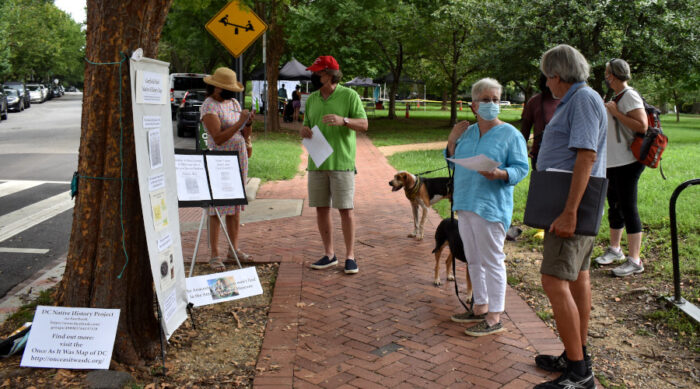
I usually go to reruns on this weekend, but given that today is now Indigenous Peoples’ Day, it seems like I should repeat something more attuned to that holiday.
Unfortunately, I do not have anything that fits the bill. The sad fact is that there is very little left over from the original residents of the area. Fortunately, there are some who are trying to change this. Chiefly in our area we have Armand Lione, a Capitol Hill resident who has been collecting what little is known about the Anacostan Indians. In August, he marked the second annual Garfield Park Native History day and came to Garfield Park with several boards displaying pictures and old newspaper clippings. During the course of the afternoon, numerous curious locals stopped by to learn what he had gleaned.
The sad fact is that there isn’t much. Most of the settlements were south of the Anacostia. On Capitol Hill proper, there seems to have been some evidence of habitation right where the Capitol now stands, as well as some further evidence – including finding a skeleton of a girl – in Garfield Park. In 1866, while a canal was being dug in Southwest DC, a fair number of artifacts were found as well.

Finally, and most intriguingly, a canoe was found deep under the Navy Yard in 1871 when they were digging the tunnel for the railroad. Sadly, in all these cases, the amount of information given in the newspapers of the day is negligible. For instance, in the last case, the entire article reads:
The workmen engaged in tunneling on the Baltimore and Potomac railroad near the navy yard, in this city, recently excavated an Indian canoe at the depths of about forty feet.
It is these tiny scraps that Lione is attempting to fit into a larger picture. You can read what he has found at his website. Particularly of interest is a 19-page summary of what he was found.
Fortunately, Lione generated a fair bit of interest with his single-handed exhibition, attracting numerous people, including Dana Hedgpeth of the Washington Post, who wrote a very nice article about Lione and his findings a few weeks later. She also spoke with officials at the National Museum of the American Indian, who promise to highlight local tribes in future exhibits. And, on a purely Hill is Home note, if you look closely at the pictures in the article, you can see two of our writers, who separately decided to check out the scene.
I hope to return to this subject in the future and try to tell some of the stories of the original inhabitants of the area.
